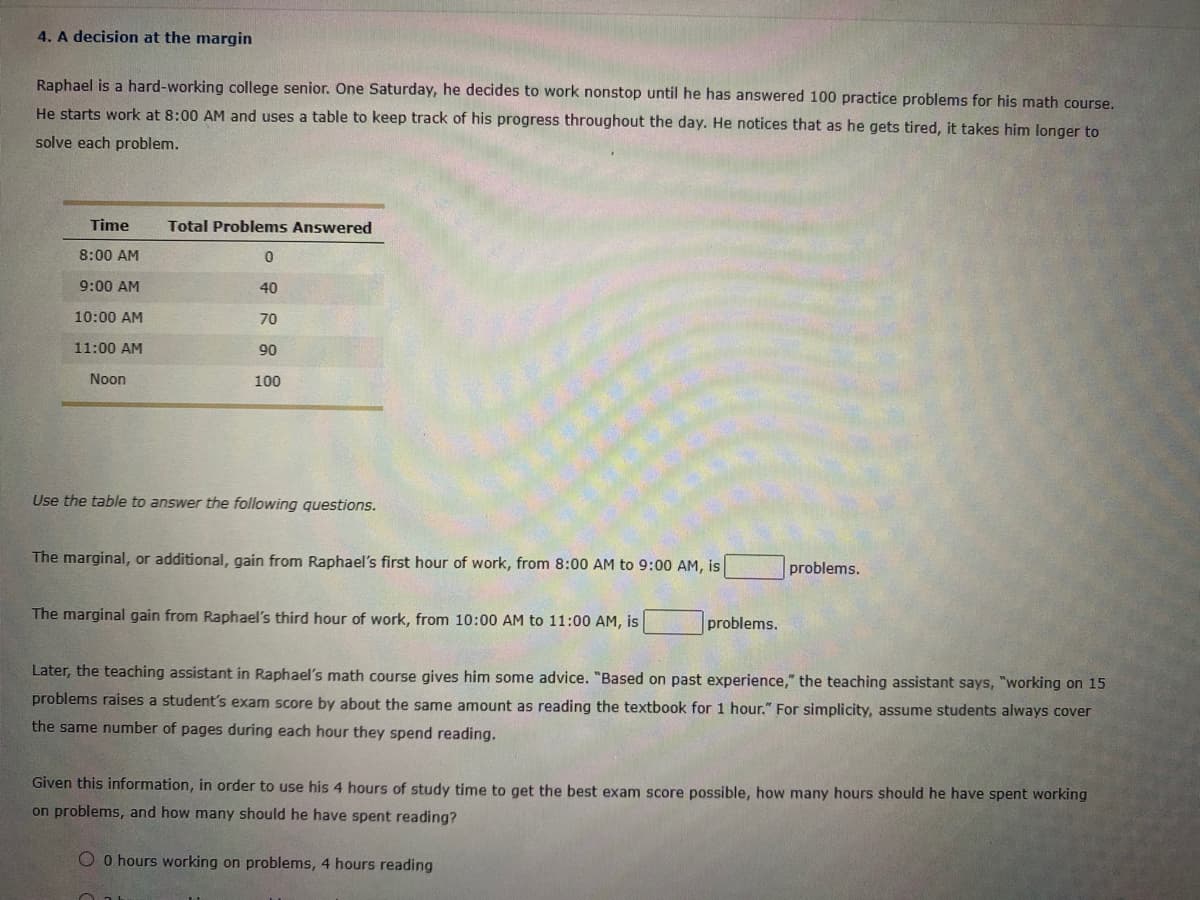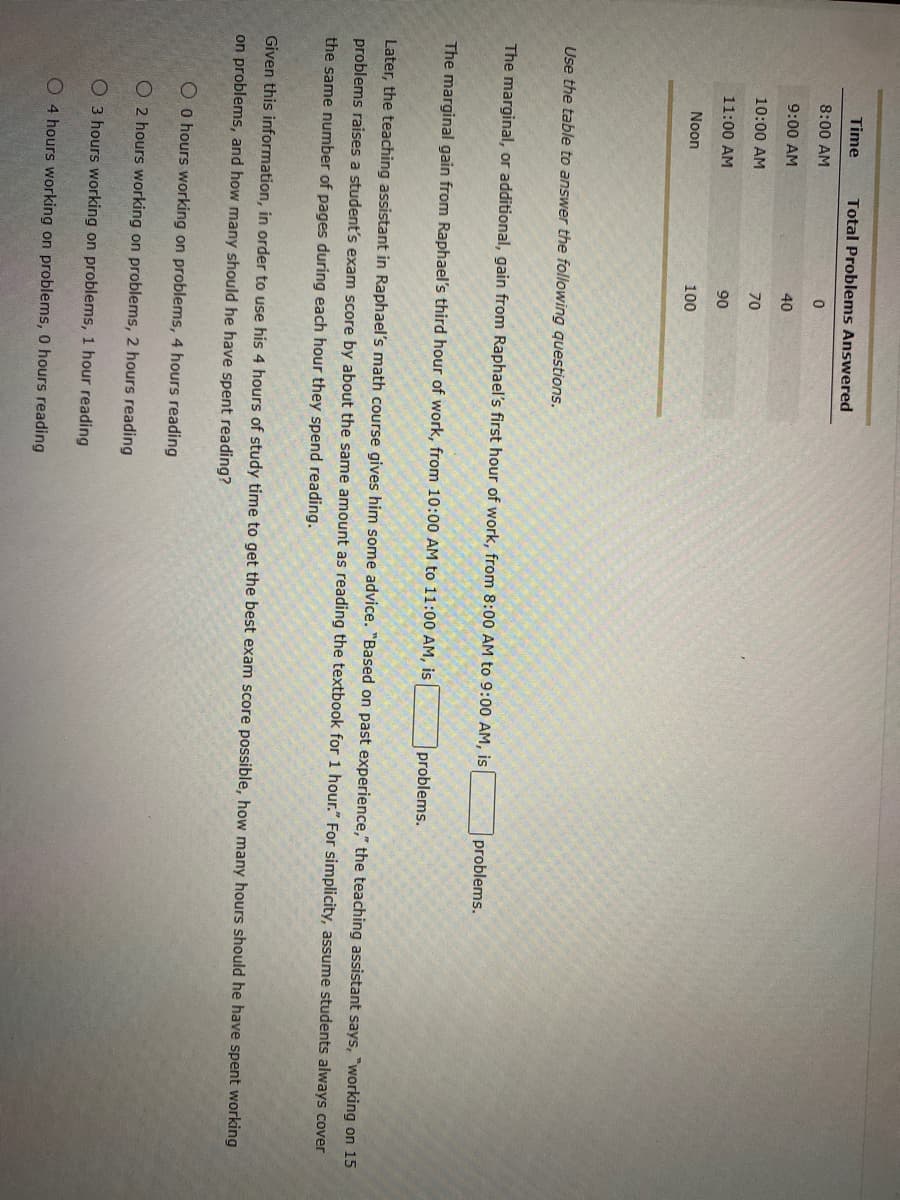4. A decision at the margin Raphael is a hard-working college senior. One Saturday, he decides to work nonstop until he has answered 100 practice problems for his math course. He starts work at 8:00 AM and uses a table to keep track of his progress throughout the day. He notices that as he gets tired, it takes him longer to solve each problem. Time Total Problems Answered 8:00 AM 9:00 AM 40 10:00 AM 70 11:00 AM 90 Noon 100
4. A decision at the margin Raphael is a hard-working college senior. One Saturday, he decides to work nonstop until he has answered 100 practice problems for his math course. He starts work at 8:00 AM and uses a table to keep track of his progress throughout the day. He notices that as he gets tired, it takes him longer to solve each problem. Time Total Problems Answered 8:00 AM 9:00 AM 40 10:00 AM 70 11:00 AM 90 Noon 100
Managerial Economics: Applications, Strategies and Tactics (MindTap Course List)
14th Edition
ISBN:9781305506381
Author:James R. McGuigan, R. Charles Moyer, Frederick H.deB. Harris
Publisher:James R. McGuigan, R. Charles Moyer, Frederick H.deB. Harris
Chapter11: Price And Output Determination: Monopoly And Dominant Firms
Section: Chapter Questions
Problem 1E
Related questions
Question

Transcribed Image Text:4. A decision at the margin
Raphael is a hard-working college senior. One Saturday, he decides to work nonstop until he has answered 100 practice problems for his math course.
He starts work at 8:00 AM and uses a table to keep track of his progress throughout the day. He notices that as he gets tired, it takes him longer to
solve each problem.
Time
Total Problems Answered
8:00 AM
9:00 AM
40
10:00 AM
70
11:00 AM
90
Noon
100
Use the table to answer the following questions.
The marginal, or additional, gain from Raphael's first hour of work, from 8:00 AM to 9:00 AM, is
problems.
The marginal gain from Raphael's third hour of work, from 10:00 AM to 11:00 AM, is
problems.
Later, the teaching assistant in Raphael's math course gives him some advice. "Based on past experience," the teaching assistant says, "working on 15
problems raises a student's exam score by about the same amount as reading the textbook for 1 hour." For simplicity, assume students always cover
the same number of pages during each hour they spend reading.
Given this information, in order to use his 4 hours of study time to get the best exam score possible, how many hours should he have spent working
on problems, and how many should he have spent reading?
O O hours working on problems, 4 hours reading

Transcribed Image Text:Time
Total Problems Answered
8:00 AM
9:00 AM
40
10:00 AM
70
11:00 AM
90
Noon
100
Use the table to answer the following questions.
The marginal, or additional, gain from Raphael's first hour of work, from 8:00 AM to 9:00 AM, is
problems.
The marginal gain from Raphael's third hour of work, from 10:00 AM to 11:00 AM, is
problems.
Later, the teaching assistant in Raphael's math course gives him some advice. "Based on past experience," the teaching assistant says, "working on 15
problems raises a student's exam score by about the same amount as reading the textbook for 1 hour." For simplicity, assume students always cover
the same number of pages during each hour they spend reading.
Given this information, in order to use his 4 hours of study time to get the best exam score possible, how many hours should he have spent working
on problems, and how many should he have spent reading?
O O hours working on problems, 4 hours reading
O 2 hours working on problems, 2 hours reading
O 3 hours working on problems, 1 hour reading
O 4 hours working on problems, 0 hours reading
Expert Solution
This question has been solved!
Explore an expertly crafted, step-by-step solution for a thorough understanding of key concepts.
This is a popular solution!
Trending now
This is a popular solution!
Step by step
Solved in 2 steps

Knowledge Booster
Learn more about
Need a deep-dive on the concept behind this application? Look no further. Learn more about this topic, economics and related others by exploring similar questions and additional content below.Recommended textbooks for you

Managerial Economics: Applications, Strategies an…
Economics
ISBN:
9781305506381
Author:
James R. McGuigan, R. Charles Moyer, Frederick H.deB. Harris
Publisher:
Cengage Learning

Brief Principles of Macroeconomics (MindTap Cours…
Economics
ISBN:
9781337091985
Author:
N. Gregory Mankiw
Publisher:
Cengage Learning

Essentials of Economics (MindTap Course List)
Economics
ISBN:
9781337091992
Author:
N. Gregory Mankiw
Publisher:
Cengage Learning

Managerial Economics: Applications, Strategies an…
Economics
ISBN:
9781305506381
Author:
James R. McGuigan, R. Charles Moyer, Frederick H.deB. Harris
Publisher:
Cengage Learning

Brief Principles of Macroeconomics (MindTap Cours…
Economics
ISBN:
9781337091985
Author:
N. Gregory Mankiw
Publisher:
Cengage Learning

Essentials of Economics (MindTap Course List)
Economics
ISBN:
9781337091992
Author:
N. Gregory Mankiw
Publisher:
Cengage Learning

Principles of Economics 2e
Economics
ISBN:
9781947172364
Author:
Steven A. Greenlaw; David Shapiro
Publisher:
OpenStax